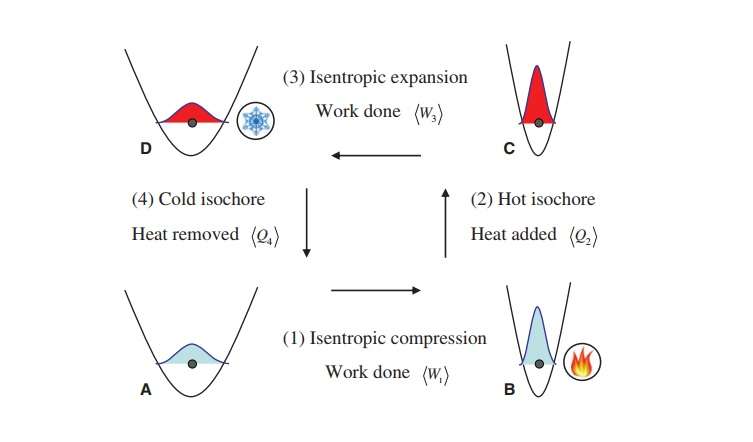A quantum engine in which work is produced during the first and third strokes. Credit: Abah et al. ©2017 EPL
(Phys.org)—Quantum engines are known to operate differently than—and in some cases, outperform—their classical counterparts. However, previous research on the performance of quantum engines may be overestimating their advantages. In a new study, physicists have developed an improved method to compute the efficiency of quantum engines. They show that the ultimate efficiency of quantum systems is subject to tighter fundamental limits than those imposed by the second law of thermodynamics, which governs the efficiency of classical systems.
Physicists Obinna Abah and Eric Lutz at the Friedrich-Alexander University Erlangen-Nürnberg in Germany have published a paper on the energy-efficient quantum machines in a recent issue of EPL. Abah is currently a Royal Commission for the Exhibition of 1851 research fellow at Queen's University in Belfast, UK.
The performance of any kind of engine—quantum or classical—is largely determined by its energy efficiency (the ratio of energy output to energy input) and its power (the rate of energy output in a given time). Conventional thermodynamics imposes a tradeoff between an engine's efficiency and its power—meaning when you increase one, the other decreases. For quantum engines, however, it's possible to increase both the efficiency and the power at the same time. This means that, with the proper methods, quantum engines can potentially produce more energy output from a given amount of energy input, and do so at a faster rate than before the improvement.
Some of the methods that allow for the simultaneous increase in efficiency and power are called "shortcut-to-adiabaticity" techniques. Adiabatic transformations are highly desirable because they dissipate little energy, which increases the efficiency of the system and speeds up the system's dynamics, which increases the system's power output. As their name implies, shortcuts to adiabaticity allow quantum machines to mimic adiabatic operation in a much shorter time than is possible using genuine adiabatic transformations, which are infinitely slow.
Although previous research has demonstrated the advantages of shortcuts to adiabaticity for enhancing the performance of heat engines, these methods typically do not account for the energy cost of the shortcut protocol when calculating the final efficiency of the system. As a result, the efficiency improvements due to shortcuts to adiabaticity appear to be for free, exaggerating their effects.
In the new study, Abah and Lutz developed a method for evaluating the performance of a system that accounts for the energy cost of these shortcuts. Their results show that shortcuts to adiabaticity enhance the performance of a system only if the shortcut is sufficiently fast, since faster shortcuts have lower energy costs. On the other hand, very slow shortcut protocols have higher energy costs that may exceed any potential energy gains.
"Our work shows that higher efficiency and higher power may be achieved at the same time with the help of shortcut-to-adiabaticty methods, even when the energetic cost of the shortcut is taken into account," Abah told Phys.org.
The physicists also showed that there is a fundamental limit to the efficiency of any quantum engine, no matter what kind of shortcuts to adiabaticity it uses. Surprisingly, the limits on a quantum engine are stricter than the limits imposed by the second law of thermodynamics, which sets the ultimate limits on the efficiency of classical engines.
As the physicists explain, the reason for the tighter bounds on quantum engines is because classical mechanics does not place restrictions on the speed of a process, whereas quantum mechanics does have speed restrictions, which are given by "quantum speed limits." The scientists plan to compare different shortcut methods in order to determine the one leading to the most energy-efficient machine. Understanding quantum speed limits and their fundamental limitations on quantum systems is essential for designing future quantum engines.
"The advent of miniaturization will unavoidably lead to machines that are so tiny that their dynamics will generally obey the laws of quantum mechanics instead of those of classical mechanics," Abah said. "Their properties will then be governed by quantum thermodynamics."
More information: Obinna Abah and Eric Lutz. "Energy efficiency quantum machines." EPL. DOI: 10.1209/0295-5075/118/40005
Journal information: Europhysics Letters (EPL)
© 2017 Phys.org
























